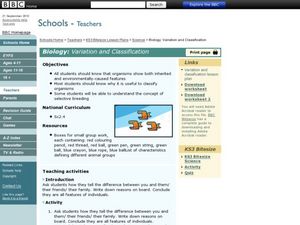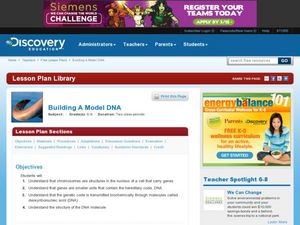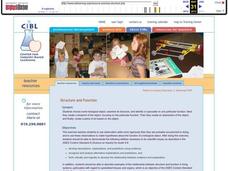Curated OER
Microscopes: Is what you see, what you got?
Eighth graders identify the parts and functions of the microscope. In this biology lesson, 8th graders observe different samples under different types of microscopes. They compare and contrast the details they see.
Curated OER
Human Traits
Students study vocabulary and complete a survey. In this human traits lesson students collect and analyze data then discuss what they learned.
Curated OER
The Skeletal System
Students identify the different parts of the skeletal system. In this biology activity, students put together a skeleton using an interactive website. They evaluate the accuracy of their own answers.
Curated OER
Biology: Variation and Classification
Pupils investigate classification of different animal groups. In this biology lesson students list characteristics of themselves and others they know to show differences and how they are classified. Pupils then answer questions...
Curated OER
Skeletal System And External Body Development Of A Full Term Fetus
Students explore the skeletal system and external body development of a full term fetus. In this biology lesson plan, students learn that growth of a full-term fetus' skeletal system and external body parts become more detailed and...
Curated OER
Making Sense of Things: The Human Body and Senses
Students conduct an experiment to evaluate the accuracy of their senses.
Curated OER
The Effects of Alcohol and other Teratogens: A model using Zebrafish
Students investigate the interference of various drugs on an embryo through experimentation. This is an open-ended lab to allow students to see effects of various chemicals humans choose to put in their bodies and create questions they...
Curated OER
Inherited Traits
Pupils work with a partner to complete an inventory of their traits and compare and discuss their unique qualities. In this biology instructional activity, students determine percentages for the frequency of observed traits of...
Curated OER
The Human Mind
Pupils read and discuss twin studies to explore the debate of nature vs. nurture. They create a list of characteristics and then look for evidence of whether it is primarily a genetic or environmental characteristic. All of the...
Curated OER
Building a Model DNA
Students explain the function of DNA in the body. In this biology lesson, students build a DNA model using simple materials. They demonstrate how bases pair up in the helix.
Curated OER
The Empirical Challenges of Racial Classification
This instructional activity will help students examine their preconceptions and assumptions about racial categories and understand the impossibility of constructing a consistent system of human racial classification.
Curated OER
Structure and Function
Structure and Function
SynopsisStudents choose some biological object, examine its structure, and identify or speculate on one particular function. Next they create a blueprint of the object, focusing on the particular function. Then...
Curated OER
Genetic Research: Decisions to be Made
Students examine the genetics involved in the human genome. They brainstorm the advantages and disadvantages to this discovery. They research different experts opinion and write a case study which addresses an ethical dilemma.
Curated OER
How Does a Pedigree Help Us to Trace a Trait That is Inherited?
Students analyze genetic patterns. In this pedigree lesson, students determine dominant or recessive inheritance. They construct a human pedigree from genetic information.
Curated OER
Comparison of Normal vs Mutant Zebra Fish Embryos
Young scholars observe and study mutations. In this mutations lesson, students work in groups to complete observation tables of various mutations of the zebra fish embryos. Groups give presentations about their observations.
Curated OER
Honeybee
Students investigate honeybees and the importance of honeybees to humans. They identify the various parts of a bee's body using velcro parts, role-play a hive, and answer review questions.
Curated OER
Food Web
Students are able to define food web, and identify the interdependence of organisms within a system. They are able to describe how natural events and human activities can impact a food web.
Curated OER
Learning the Dissecting Planes
Students explore dissecting planes. In this biology lesson plan, students learn the basic vocabulary used in dissection, learn how to orient themselves on a three dimensional figure, and develop the manual dexterity necessary to use...
Curated OER
The Opposable Thumb
Students explore the physical importance of the opposable thumb among primates. They discover which of their simplest daily activities are possible only because of their opposable thumbs.
Curated OER
Observing and Drawing Structures of Guppies and Goldfish
Students observe fish and focus on their structures. In this life science lesson, students work in a group and observe guppies and gold fish.
PBS
Lesson Plan: “Seeing the Way: A Brief History of Cataract Surgery”
After looking at the history of cataract surgery techniques, your high schoolers will have a new perspective on medical and scientific advances. Kids alternate between watching short video clips, class discussion, and computer research....
Sunlight Cal-Tech
Chromatography of Plant Pigments
Through a hands-on activity, an acetone-spinach solution is pre-made and learners use this solution to separate the pigments found in spinach using chromatography. The comprehensive resource includes an analysis and conclusion...
Curated OER
Telling Our Own Stories
Explore online profiles and social media with your middle and high school classes. Use blogs to inspire your class to craft a well-written, thoughtful response to a prompt you give. A few example prompts are given.
Curated OER
What Is It?!
Working individually or in groups, 4th graders are presented with unusual or at least unfamiliar objects and are asked to speculate on what they are and/or how they are used. The intention is to get students to make careful observations...























